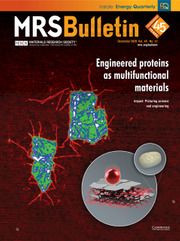Crossref Citations
This article has been cited by the following publications. This list is generated based on data provided by
Crossref.
Park, SooHyun
Kang, You Jung
and
Majd, Sheereen
2015.
A Review of Patterned Organic Bioelectronic Materials and their Biomedical Applications.
Advanced Materials,
Vol. 27,
Issue. 46,
p.
7583.
Janíková-Bandžuchová, Lenka
Šelešovská, Renáta
Schwarzová-Pecková, Karolina
and
Chýlková, Jaromíra
2015.
Sensitive voltammetric method for rapid determination of pyridine herbicide triclopyr on bare boron-doped diamond electrode.
Electrochimica Acta,
Vol. 154,
Issue. ,
p.
421.
Švorc, Ĺubomír
Jambrec, Daliborka
Vojs, Marian
Barwe, Stefan
Clausmeyer, Jan
Michniak, Pavol
Marton, Marián
and
Schuhmann, Wolfgang
2015.
Doping Level of Boron-Doped Diamond Electrodes Controls the Grafting Density of Functional Groups for DNA Assays.
ACS Applied Materials & Interfaces,
Vol. 7,
Issue. 34,
p.
18949.
Talbi, A.
Soltani, A.
Rumeau, A.
Taylor, A.
Drbohlavová, L.
Klimša, L
Kopeček, J.
Fekete, L.
Krečmarová, M.
and
Mortet, V.
2015.
Simulations, fabrication, and characterization of diamond‐coated Love wave‐type surface acoustic wave sensors.
physica status solidi (a),
Vol. 212,
Issue. 11,
p.
2606.
de Lima Batista, Ana Paula
and
Ornellas, Fernando R.
2015.
CASSCF and MRMP2 investigation of the interaction of arsenic adatoms with carbon dimers on the diamond (100)-2 × 1 surface.
Surface Science,
Vol. 641,
Issue. ,
p.
159.
Patten, Hollie V.
Hutton, Laura A.
Webb, Jennifer R.
Newton, Mark E.
Unwin, Patrick R.
and
Macpherson, Julie V.
2015.
Electrochemical “read–write” microscale patterning of boron doped diamond electrodes.
Chemical Communications,
Vol. 51,
Issue. 1,
p.
164.
Macpherson, Julie V.
2015.
Electrochemistry of Carbon Electrodes.
p.
163.
Lockett, Matthew R.
and
Smith, Lloyd M.
2015.
Carbon Substrates: A Stable Foundation for Biomolecular Arrays.
Annual Review of Analytical Chemistry,
Vol. 8,
Issue. 1,
p.
263.
Quast, Arthur D.
Bornstein, Megan
Greydanus, Benjamin J.
Zharov, Ilya
and
Shumaker-Parry, Jennifer S.
2016.
Robust Polymer-Coated Diamond Supports for Noble-Metal Nanoparticle Catalysts.
ACS Catalysis,
Vol. 6,
Issue. 7,
p.
4729.
Izquierdo, Javier
Mizaikoff, Boris
and
Kranz, Christine
2016.
Surface‐enhanced infrared spectroscopy on boron‐doped diamond modified with gold nanoparticles for spectroelectrochemical analysis.
physica status solidi (a),
Vol. 213,
Issue. 8,
p.
2056.
Siddiqui, Shabnam
Dutta, Gaurab
Tan, Chao
and
Arumugam, Prabhu Umasanker
2016.
Nanocrystalline Diamond Electrodes: Enabling electrochemical microsensing applications with high reliability and stability.
IEEE Nanotechnology Magazine,
Vol. 10,
Issue. 3,
p.
12.
Coffinier, Yannick
Boukherroub, Rabah
and
Szunerits, Sabine
2016.
Carbon Nanoparticles and Nanostructures.
p.
331.
Yurov, Vladimir
Bushuev, Egor
Bolshakov, Andrey
Ashkinazi, Evgeny
Antonova, Irina
Zavedeev, Evgeny
Khomich, Andrey
Voronov, Valery
and
Ralchenko, Victor
2017.
Etching Kinetics of (100) Single Crystal Diamond Surfaces in a Hydrogen Microwave Plasma, Studied with In Situ Low‐Coherence Interferometry.
physica status solidi (a),
Vol. 214,
Issue. 11,
Szunerits, Sabine
Coffinier, Yannick
and
Boukherroub, Rabah
2017.
Carbon-Based Nanosensor Technology.
Vol. 17,
Issue. ,
p.
1.
Raymakers, Jorne
Artemenko, Anna
Nicley, Shannon S.
Štenclová, Pavla
Kromka, Alexander
Haenen, Ken
Maes, Wouter
and
Rezek, Bohuslav
2017.
Expanding the Scope of Diamond Surface Chemistry: Stille and Sonogashira Cross-Coupling Reactions.
The Journal of Physical Chemistry C,
Vol. 121,
Issue. 42,
p.
23446.
Nistor, P. A.
and
May, P. W.
2017.
Diamond thin films: giving biomedical applications a new shine.
Journal of The Royal Society Interface,
Vol. 14,
Issue. 134,
p.
20170382.
Carabelli, Valentina
Marcantoni, Andrea
Picollo, Federico
Battiato, Alfio
Bernardi, Ettore
Pasquarelli, Alberto
Olivero, Paolo
and
Carbone, Emilio
2017.
Planar Diamond-Based Multiarrays to Monitor Neurotransmitter Release and Action Potential Firing: New Perspectives in Cellular Neuroscience.
ACS Chemical Neuroscience,
Vol. 8,
Issue. 2,
p.
252.
Lang, Daniel
and
Krueger, Anke
2017.
Functionalizing nanodiamond particles with N-heterocyclic iminium bromides and dicyano methanides.
Diamond and Related Materials,
Vol. 79,
Issue. ,
p.
102.
Krueger, Anke
2017.
Nanodiamonds.
p.
183.
Larsson, K.
and
Tian, Y.
2018.
Effect of surface termination on the reactivity of nano-sized diamond particle surfaces for bio applications.
Carbon,
Vol. 134,
Issue. ,
p.
244.



